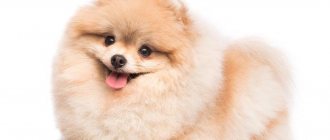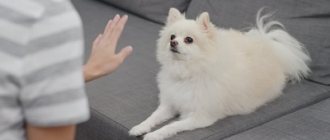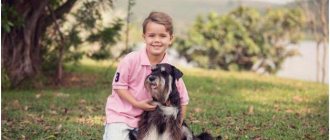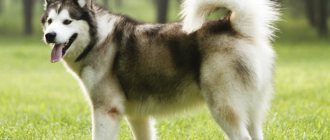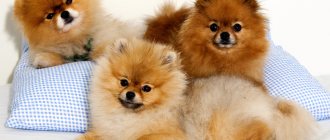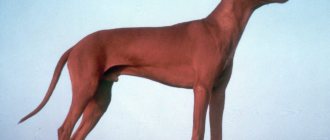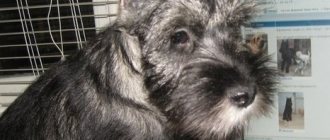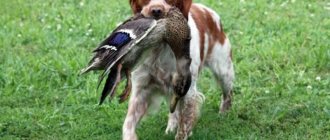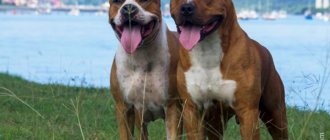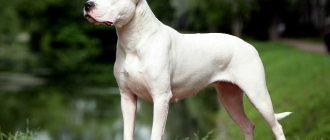A properly raised Pomeranian is wary of strangers. He doesn’t show aggression first, but he also won’t allow anyone to touch his luxurious fur coat. Without proper training, the dog will bark at every passerby on the street, and ring a bell at any rustle in the apartment. To avoid conflicts with neighbors, your pet’s behavior needs to be corrected from childhood.
Poms get along quite well with other dogs and cats, especially if they grew up with them, but they periodically strive for dominance. When a second dog appears in a house where an adult Spitz lives, the owner will have to make an effort to make friends with the pets. To do this, you need to pay no less attention to Pomeranz than before. Otherwise, the pet will begin to prove to the owner that he is still the boss in the house and will become aggressive towards the newcomer. Spitz dogs should not be kept together with small pets (birds, hamsters, rats, etc.). Like the Karelo-Finnish husky, doggies have a very strongly developed hunting instinct.
Command training
Training and attitude towards it
The first step should not be training, but raising the pet. You need to teach your baby the rules of behavior in a new home from the first days.
All family members will have to show firmness. Fluffy puppies are very stubborn, they will quickly figure out the “weak link”, begin to manipulate, and set their own rules. The second important point is training in hygiene procedures.
Owners should be prepared for the fact that at first (up to about 6 months) the puppy will relieve itself in the apartment. Getting him used to walking will take time and patience. To begin with, you can lay out a diaper and sit your Spitz on it immediately after sleeping and eating. “Accidents” sometimes occur in adults as well. Due to the peculiarities of their physiology, it is difficult for Pomeranians to hold urine in a bladder for a long time, but well-mannered dogs know how to ask to go outside as needed.
When the little Pomeranian gets a little comfortable in the new place, you can begin to master the basic commands. Not only the comfortable coexistence of people and dogs, but, above all, the safety of the pet itself depends on the accuracy of their implementation.
It is recommended to study the commands in this order:
- “place”, “impossible”, “fu”;
- “to me”, “sit”;
- “lie down”, “stand”;
- “can”, “near”, “give”;
- “wait”, “voice”, “walk”, “fetch”.
In the case of the Pomeranian, it is very important to teach your pet the command “to be silent.”
Dogs are prone to barking for no reason. Babies usually receive the basics of upbringing in the breeder’s home; the owner’s task is to consolidate the acquired skills and continue the development of the Spitz. Pets have different abilities, but dogs master the full course of the listed commands (subject to daily exercise) by 6-7 months. A new order should begin to be learned only after the Spitz has fully mastered the previous one. There should be no breaks in classes, otherwise the child will forget some of the loose skills, and everything will have to start all over again.
Pomeranians are endowed with high intelligence and are quite trainable. The only thing that gets in the way is their stubbornness and desire to demonstrate independence. The main thing is not to make the mistake of mistaking Poms for stupid kids because of their touching appearance. Dogs must respect their owner and be aware of his dominant role. If you do not show strength of character, the Pomeranian will consider itself the “leader of the pack” and will not follow the orders of the owner.
You cannot hit or scold the dog! Representatives of this breed cannot tolerate rudeness or cruelty. In response, they show uncontrollability or aggression. You need to encourage your baby with a favorite treat or praise. Dogs love to be praised, they subtly sense the intonations of the human voice, strive to please their owner, and will be able to master not only basic commands, but also some circus tricks. In such an atmosphere, classes will be effective and will bring a lot of pleasure to both the owner and the dog.
Upbringing
The mini Pomeranian is smart, quick-witted, remembers commands, and does complex tricks like seeds.
But there are a lot of ill-mannered Pomeranians. What is the reason? The fact is that owners of decorative breeds consider small dogs not dangerous. This means there is no need to deal with them. The result is an unbalanced Miniature Spitz, who feels like he is the head of the family and almost the center of the Universe.
This position is dangerous. The mini-Spitz doesn't look scary. But any dog is a bladed weapon. A bitter orange bite hurts, it can tear muscles and bite through veins. Not to mention the fact that an ill-mannered miniature spitz ruins the nerves of its owners and those around them.
Pomeranian puppies should be taught discipline from the first minutes in their new home. The rules are set once and for all. Up to 4 months, the Pomeranian is simply raised, and then commands from the main training course are introduced.
Training the Miniature Spitz is complicated by its tendency to be stubborn and manipulative. Plus, pets have a delicate, easily excitable nervous system. Therefore, you need to find a balance between hardness and softness, to be an affectionate, loving, but demanding owner who is not forgiving of antics.
The main skills that a miniature Spitz must learn, in addition to OKD, are the ability to remain alone and not bark in vain. Any causeless barking is stopped at the first yelp, and they are gradually accustomed to loneliness, leaving the Miniature Spitz at first for a couple of minutes, gradually increasing the time to several hours.
The difference between a dog and a bitch
The main external and behavioral characteristics of the Pomeranian breed are inherent in individuals of both sexes, but there are still some differences between them. Thus, males are always the brighter representatives of the breed. Male poms are superior to females in appearance, have a more luxurious coat, and look better at shows. In addition, Spitz males shed less often and do not lose hair as much during seasonal shedding.
Males of this breed are more emotional and openly express their love and devotion to their owners. Males are less touchy, but more stubborn and cocky.
The main unpleasant aspects of keeping male Pomeranians are urine getting on the fur on the tummy and possible marks in the apartment. These points can be easily corrected by a suitable haircut, proper upbringing and timely walking of the pet. A properly cut Spitz does not have any unpleasant odors.
Another point is the “rut”. Even the most trained dog, having smelled a “dog wedding,” can become uncontrollable and run away from its owner.
Spitz females are very clean. Their long fur always looks neat, but they shed more. In addition to the seasonal change of hair, the female loses her undercoat before estrus, greatly “sheds” her hair after giving birth, then quickly grows back. During these periods, dogs require special care and enhanced nutrition.
By nature, Pomerantsev bitches are more cunning than males. They know how to find an approach to the strictest owner and know when to show tenderness. Females are more flexible and are not prone to escape.
Grooming
Character of the German (Pomeranian) Spitz and photos of dogs
By nature, German Spitz are friendly, affable, affectionate, and devoted to their owner. There is no anger, aggression, or importunity in them. They are slightly wary of strangers, but are not afraid of strangers. These animals, despite their compact size, become excellent watchmen and guardians of household property.
This photo clearly shows the external features of the small German Spitz.
As a rule, dogs of the German Spitz breed are family favorites, which is due to many positive traits in their character. These animals are affectionate, sociable, friendly, cheerful, active, determined and very brave. They become wonderful friends and companions for all household members, to whom they quickly get used to and become attached. In addition, dogs easily adapt to new living conditions and easily adapt to the rhythm of life of their owners. With older owners they behave quietly and calmly, with young owners they are more active. They love to get the attention of others and try to attract it to themselves in all possible ways: loud barking, jumping and running around family members. However, such pets will never get bored and if they feel that there is no need for their presence, they will go into their own corner.
By nature, the German Spitz dog is self-sufficient, intelligent and loyal. The animal is easy to train, quickly remembers even complex commands, and strives to conquer new heights.
The favorite activities of representatives of this breed are long walks in the fresh air (without a leash), running, games, and swimming. That is why they are ideal for people with an active lifestyle, who love to travel, relax outside the city, etc.
Care and maintenance in the apartment
Let's now talk about how to properly care for a dog. Pomeranians are suitable for keeping in a city apartment or private house, but not on the street.
Miniature dogs are not intended for kennel (especially chain) life. Before the puppy arrives, you need to prepare a corner where the baby will feel safe.
The best option is a house made of fabric and padding polyester in which the dog will sleep. It should be placed in a part of the apartment that is protected from drafts and not too dark. It is better to install a “shelter” in the master bedroom so that the pet does not feel abandoned. You cannot take a puppy into your bed. Firstly, it is unsafe for the fragile Spitz. Secondly, it will be impossible to wean him off spending the night together.
In addition to the main house, you will need a bed, which will be located in the kitchen or in the room where the family spends time more often, because Pomeranians love to be with people. It is important to remember that little bullies prefer active games. To prevent him from using things that are absolutely not intended for this purpose for his fun, the baby must be provided with a sufficient number of rubber toys.
For walks you will need a collar or harness. Some owners consider a harness not the best choice, since the hair gets wiped out under the straps and bald patches form. However, if the dog runs around a lot outside, walks are frequent and short, you can buy a harness.
The collar should be leather or nylon, soft but durable. It must be tightened so that a human finger fits between the collar and the dog’s neck, otherwise the accessory will compress the dog’s airways.
A Spitz leash must be strong, thin and light in order to withstand an unexpected jerk if the pet suddenly wants to rush after a pigeon or cat. The optimal length is 5 meters. The dog will be able to move freely while remaining under control. Roulette is also a good option.
Muzzles for Pomeranians are usually made to order. Their faces are poorly suited for wearing such restraints. A muzzle will be required if the dog behaves aggressively, grabs passersby by the legs, or constantly picks up something from the ground.
Clothes for Poms, despite the presence of a thick undercoat, are also necessary. Overalls are needed not to insulate a pet, but to protect a chic fur coat from contamination in the off-season. A T-shirt, shirt or blanket will be needed during walks in the summer heat to protect the baby from overheating. Other elements (skirts, dresses, ties) are sometimes needed for participation in exhibitions. All things must be made from natural materials and fit freely on the dog.
At home, Pomeranz's clothes need to be taken off!
There is no great need for shoes - they are a fashionable element of a dog's wardrobe. If the baby categorically refuses to wear shoes, he should not be forced.
Hygiene
The main difficulty lies in caring for your pet’s luxurious coat. Pomeranians are less susceptible to matting than other long-haired breeds, but it is sometimes necessary to comb them out. A special tool will help you with this.
Combing wool
The procedure should be carried out three times a week, during the molting period - daily. For manipulation you will need a massage brush and a comb with long teeth. It is advisable to first spray the fur with a special spray to avoid splitting the ends of the hairs. Particularly carefully and correctly it is necessary to comb the groin, armpits, and areas behind the ears. Pomov's hypoallergenicity is a myth. Such dogs can provoke an allergic reaction in allergy sufferers, just like any other.
Bathing
Pomeranians should not be washed frequently. It is better to do this no more than once a month, only if it is heavily soiled. It is better to wash the baby with diluted shampoo for dogs of long-haired breeds; be sure to use conditioner.
A haircut
Do you need to cut your dog's hair? Certainly! This is the only way she will look beautiful and neat. To cut Pomeranians, buy thinning scissors. Usually the fur is trimmed slightly to maintain a neat appearance. When preparing for exhibitions, you need to round off the ears, shape the collar and “pants” - this is best left to a professional groomer. For hygiene purposes, you need to carefully trim the lint between your fingers and around the anus.
The machine cannot be used! This will disrupt the hair structure.
In addition to haircuts, when caring for Poms you need to:
Teeth cleaning
Brush your teeth with veterinary paste 2-4 times a week. This can be done with a soft brush or by wrapping your finger in a clean bandage. To prevent tartar from forming, it is good to buy special treats.
Nail trimming
Nails should be trimmed as needed using a nail clipper for toy breeds. Finish the edges with a nail file. The dog's paws should be washed after every walk, and vegetable oil should be rubbed into the pads - this will help prevent painful cracking.
Ear treatment
Pomeranian ears should be regularly inspected, cleaned with a special lotion to remove accumulations of sulfur and dust, and hairs should be plucked. For the procedure, use cotton pads; you cannot clean the ears with ear swabs; this method can cause serious injury to the dog.
Eyes
Now about why your eyes water so often. Due to their anatomical features, Pomeranians are prone to excessive tearing. It occurs more often during wind, dust storms, and hot weather. To eliminate the problem, you need to contact your veterinarian and ask to prescribe suitable eye drops.
It's better to have two bowls
German Spitz care, haircut and trimming
Caring for a German Spitz should be carried out from the first days of its life. A place should be allocated for your pet where he can rest and spend his time quietly without disturbing family members. At the age of 2 months, he can be accustomed to walking in the fresh air, starting from 15 to 20 minutes. per day, gradually increasing the time. Washing paws, brushing teeth, water procedures, and combing are also taught from an early age.
To keep your dog's coat thick and beautiful, it needs to be groomed regularly. As a dog grows, its coat constantly changes. Puppies are born with short, smooth hair that grows up within a few weeks. After 2 months, the undercoat grows and a collar forms. By 3 months, the puppy becomes like a fluffy ball, after which periods of molting begin. With proper and systematic care, there will be no hair in the house. This is due to the fact that the dense undercoat firmly holds itself and the guard hairs. A special brush and comb are used for combing. Use a comb to comb out the tangled tangles and thorns of plants that form on the long coat and stick to the dog during a walk. In addition, the comb fluffs up the hairs, which makes the appearance of the animal very impressive. The brush is suitable for daily combing. This procedure is performed starting from the back or chest of the animal, gradually moving forward and dividing the hair into strands to speed up and make the work easier. The last thing to comb is the tail, starting from its base. The undercoat is combed out only during periods of shedding.
Grooming a German Spitz is done only if it does not spoil the appearance of the pet. Trimming is necessary to maintain a neat appearance of the dog and get rid of clumps of fur. It is enough to do this once a week. The hair on the tail should not be cut too short, otherwise it will lose its inherent luxury. I trim the tangled pieces on the paws, and lightly trim the areas at the back and sides.
When trimming, special attention is paid to the treatment of the ears. The length of the hairs on the inner edges should not exceed 0.6 cm, on the outer edges - 1.2 cm. For safe and accurate trimming, small nail scissors should be used. Long hairs in the ears are plucked out.
Many owners of German Mini Spitz mistakenly believe that they need to be washed frequently. In fact, the dog only needs a bath if it gets dirty, or before a show. After washing, the wool is thoroughly wiped with a towel and then dried under a hair dryer. To maintain cleanliness, it is enough to wipe the animal’s paws every time after a walk.
In order for your German Miniature Spitz to look well-groomed, like in the photo below, it is important to take care of its nails:
Excessively grown nails are very noticeable and spoil the overall appearance of the dog. They are removed using a nail clipper and then polished with a file. This “manicure” should be done once every 2 months.
What to feed
The Pomeranian Spitz is suitable for both natural feeding and industrially produced food.
Breeders recommend the second option to novice dog breeders, since factory products are well-balanced in protein, fat and carbohydrate content, enriched with all the necessary vitamins and microelements, and the dog eats them well.
The best dog food is at least premium class. Economy-class goods, offered in large quantities by supermarkets, are dangerous to animal health. When choosing food, you need to carefully study its composition. In a good product, meat comes first in the list of ingredients (accounting for at least 30%). You also need to check the presence of vitamins and minerals in the list.
You should refuse to purchase food if it contains:
- offal;
- cellulose;
- sugar;
- nutshell;
- caramel;
- chemical preservatives, flavorings.
Pomeranians are well suited for food brands such as:
- Now Natural Holistic;
- Purina Pro Plan;
- Hills;
- Royal Canin;
- Optima Nova.
If the owner decides to cook for the dog himself, he will have to maintain the optimal ratio of the main elements. Half of the total daily diet should be protein foods, 30% should be cereals, 20% should be vegetables.
The best meat products for Pomeranians are beef and veal. Sometimes they can be replaced with chicken or turkey. The meat should not be boiled, but pre-frozen in the freezer (at least 15 hours). This way you can get rid of helminths while preserving the maximum of nutrients. By-products should not be given to Spitz dogs often - they can cause stomach upset in dogs.
In addition to meat, the diet should contain:
- buckwheat grain;
- vegetables. It is better to give them raw, grated;
- cottage cheese;
- rice;
- fruits;
- oatmeal;
- eggs (a couple of times a week). The product must be administered carefully, first give the dog the yolk, then the white. If no allergic reaction occurs, eggs can be given whole, boiled or raw;
- sea fish, boned;
- kefir, yogurt. Adults do not need to be given milk. It is not absorbed by the body.
What you should not feed your Pomeranian:
- fatty meat;
- onions;
- legumes;
- beets;
- grapes;
- smoked meats;
- baked goods;
- mushrooms;
- persimmon;
- sweets;
- potatoes;
- tubular bones;
- garlic;
- raisins;
- fresh bread;
- sausages.
Vitamin supplements can only be given to dogs as prescribed by a veterinarian!
The combined type of feeding for Poms is not recommended - the stomach of these dogs does not react well to frequent changes in food. An adult dog should eat twice a day in approximately equal portions, and constant access to clean water is required. And of course you will need at least two bowls for food and drink.
Read about the nutrition of older dogs in a special article.
The best option would be to purchase a special automatic dog feeder that will feed your pet strictly on an hourly basis, even in your absence. It is also recommended to add a water fountain so that the dog is provided with filtered, oxygenated water.
Dry food contains everything you need for growth
Expressive muzzle
Adorable dogs of the Pomeranian Spitz breed are distinguished by an elegant and slightly elongated muzzle, which in appearance is similar to the physiognomy of a fox.
As for the shape of this expressive part of the body, it can be one of three varieties:
- Bearish.
- Fox.
- Toy.
The bear's face is flattened and rounded in shape, with fluffier fur on the cheeks. The eyes are located in close proximity to the nose. These features are reminiscent not of a miniature dog, but of a small bear cub. When you meet something like this in the middle of an unfamiliar area, you can’t help but look around in search of an angry mother.
The more elongated fox face gives a truly believable resemblance to this cunning forest dweller. They even have a longer tail than other representatives of the Spitz breed.
As for the toy look, this form was imported straight from Japan. The muzzle is flatter compared to the first type. The eyes are located higher and further apart.
What is characteristic is that it is the fox form of the smallest Spitz in the world that is allowed to participate in competitions, while the remaining varieties appear as pets. In the standard characteristics section there is a description of the fox type.
Table of height and weight by month
Now about how much a Pomeranian Spitz should weigh. The development of different lines may differ significantly. Thus, some individuals reach the weight and height of adult dogs by 4 months, while in others this process is completed by nine months.
On average, it is believed that the period of intensive growth of Pomeranians ends at six months of age; they continue to gain body weight for some time. In a bitch, development may stop completely or temporarily during the first heat. Full physical development of representatives of this breed is completed by 2-3 years.
The rate of growth and weight gain of a puppy is influenced by various factors: heredity, diseases suffered at an early age, level of activity, approach to breeding dogs.
Some unscrupulous “breeders” deliberately underfeed puppies in order to pass them off as a dwarf variety and sell them at a higher price! Subsequently, such malnutrition will inevitably have a negative impact on the pet’s health.
The organization of nutrition by the owner himself has a huge impact on the full development of Poma. At first, it is better to feed the puppy what he ate at the breeder's house (you can ask for some food). Then, gradually, the baby can be transferred to the type of food preferred by the new owner.
This should be done gradually, adding one new product every 3-4 days, and observing the puppy’s reaction to unfamiliar food. Dry food should be selected according to the age of the Spitz. Giving your puppy food for adult dogs is prohibited!
The number of meals changes as the pet gets older:
- up to 2 months the puppy eats 6 times a day;
- from 2 to 3 months - 5;
- from 3 to 6 months - 4;
- from 6 to 8 months - 3 times a day.
After eight months, Pomeranz is gradually transferred to a two-time feeding regimen. Food should be given out at the same time, adjusting the portion size. This can be done by observing the baby. When he greedily licks an empty bowl, the amount of food should be increased; if there is food left in the cup, it should be reduced.
One of the indicators of the correct development of Pomerantz is his weight. You can estimate body weight by the type of pet:
- when the ribs can be clearly felt, there is practically no fat layer, the Spitz is underweight;
- if the ribs cannot be felt and are covered with a thick layer of fat, the baby becomes obese;
- with normal weight, the ribs can be felt, but the pits between them are insignificant, the layer is dense and of normal thickness.
To fully assess your pet's condition, it is necessary to weigh it regularly. We present the norms for weight gain by Pomeranian Spitz in the form of a table.
| Pomeranian age by month | weight depending on subtype (g) | ||
| standard | mini | dwarf | |
| At birth | 130-140 | 105-125 | 70-95 |
| 1 month | 460-490 | 325-370 | 210-275 |
| 2 months | 680-770 | 550-620 | 320-460 |
| 3 months | 1000-1150 | 800-920 | 460-690 |
| 4 months | 1300-1450 | 1000-1175 | 600-880 |
| 5 months | 1550-1700 | 1200-1350 | 700-1030 |
| 6 months | 1700-1900 | 1300-1500 | 770-1150 |
| 1 year | 2100-2300 | 1700-1900 | 1000-1400 |
Minor (5-10%) deviations from the norm are not a cause for serious concern if the baby is playful, eats well, and looks harmonious. Perhaps the dog has a light frame or is not growing evenly, over time it will “catch up” with its brothers. Underweight of more than 10% of the norm is a reason to contact a veterinarian. Most likely you will have to increase the calorie content of food or physical activity. If the cause of your Spitz's slow development is a previous illness or mistakes in breeding, serious treatment may be required.
Interesting facts about German Spitz dogs
German Spitz dogs have pronounced leadership abilities, for which breeders in their community call them “Napoleons”. If you do not pay attention to upbringing and training at an early age, puppies will grow up to be overly excitable, disobedient dogs that attack strangers.
The dog's thick fur is never completely cut off, but it is regularly shortened on the ears, paws and in the groin area.
Another interesting fact about German Spitz dogs is that their coat (especially the coat of Wolfspitz dogs, the largest representatives of the breed) does not have the characteristic dog smell.
Advantages and disadvantages
When choosing a pet, it is important to take into account all the positive and negative qualities of a particular breed.
Among the main advantages of Pomeranians are:
- magnificent appearance;
- good learning ability;
- devotion to the owner;
- fairly good health (with the exception of dwarf individuals);
- cheerful disposition, energy;
- gets along well with children and other animals;
- suitable for keeping in a city apartment;
- They tolerate travel and changes of environment very well.
Cons of the Pomeranian:
- the high cost of the dog itself and its maintenance;
- requires serious education;
- needs long walks;
- complex grooming;
- stubbornness;
- tendency to bark for no reason;
- not suitable for outdoor living.
Pom shows its negative qualities only in the absence of proper care and education. You will have to do a lot of work with the dog; the owners will need patience and perseverance. Pomeranians are not suitable as a first dog.
Puppies are absolutely charming
Owner reviews
On the Internet you can find both positive and negative reviews from Spitz owners. If you look at it, the negative experience of ownership is based on the unpreparedness of the future owner to raise and communicate with a temperamental dog.
Irina S. I didn’t even know there were so many Spitz dogs! I thought it was a Pomeranian plush miracle, German and that’s it. But it turned out there was a whole group of them. I learned this when we were looking for a hunting dog for my husband. We bought a Finnish one. What a redhead he is - it even blinds your eyes when he runs through the white snow. But the character is complex. She loves her husband immensely. The rest, it seems to me, he simply respects as members of his family. We live in a private house, the dog walks and exercises a lot. This is a must.
Maxim O. Gave his wife a Pomeranian. I thought that “bear cub” was an affectionate nickname. And this is the type of dog. It seemed like I had come to a toy store - the puppies seemed unreal. I thought the dog would only be for his wife, but he became attached to the little one. Very smart, protective.
Oleg R. I have a Wolfspitz. Really looks like a wolf and has the same stern disposition. The first dog of this type, so he made a lot of mistakes. Since childhood, I treated him like a funny fluffy bear and allowed me a lot. I grew up and problems began. He is not evil, but stubborn. If he doesn't want to, he won't do it. We went to dog trainers and corrected all the flaws in our upbringing. What can I say - any dog needs training. This is a living creature, it wants to walk, eat tasty food and communicate with people.
Mating, pregnancy, childbirth
The Pomeranian's first heat occurs between 8 and 12 months. It is impossible to knit a girl at this age, since the body is not yet fully formed.
Early pregnancy and childbirth are dangerous for the health of the pet and can result in the birth of non-viable offspring.
It is recommended to cross a Pomeranian bitch for the first time at about two years of age (on her third heat). The same rules apply to male dogs.
Spitz females can become pregnant after each heat, but this should not be allowed more than once every 1-1.5 years. Childbirth and breastfeeding exhaust the bitch's body and she needs time to fully recover.
A pair for mating is selected through a club or nursery. It is important that both dogs have a full package of documents, undergo the necessary tests for the presence of genetic diseases, vaccination and deworming procedures.
Female Pomeranians weighing less than 2 kg are excluded from breeding.
Pregnancy in the Pomeranian Spitz lasts from 58 to 64 days. Some individuals give birth on day 67 - this is also considered the norm. Puppies born before day 57 usually die. If labor does not occur longer than 70 days after mating, you need to contact a veterinarian - the pregnancy may be frozen. You cannot give your pet stimulants on your own! Such actions can lead to injury and uterine rupture. Such medications are used only by a doctor.
You need to be well prepared for the birth of your babies. Organize a comfortable “nest” for the bitch in which she can safely give birth. It is desirable that it consist of two sections. In one there will be newborn babies, in the other - a giving birth bitch.
About 7 days before giving birth, the female’s stomach drops, the vagina increases in size, and the back sags. The day before the puppies appear, the Spitz's body temperature drops to 37 degrees. The bitch becomes nervous, loses her appetite, and does not leave her owner’s side. She needs to be reassured, not left alone, and shown an organized place to give birth.
The process itself is usually easy for Pomovs and does not require emergency assistance. The first baby, when born, causes pain to the mother, the bitch may begin to whine. Other puppies are born less painfully.
Newborn puppies “come out” in the placenta. More often the bitch chews it herself. If this does not happen, the dog will have to help: grab the bubble with a clean gauze, tear it near the puppy’s muzzle, and remove it. You need to hold the baby upside down, clear the mouth and nose of mucous secretions, and blow into the face. If the puppy squeaks and starts spinning, then everything is fine. The umbilical cord must be cut with sterile scissors three centimeters from the tummy. You cannot tie it in a knot.
Little Pomeranians are born 15 to 30 minutes apart. After giving birth, the bitch should be given water with a small amount of honey (but not sugar). If she asks for food, you can give her some kefir or cottage cheese. You also need to provide her with a tray to relieve herself. When a female asks to go outside, she should be carried out in her arms and not allowed to walk around much. The vagina, tummy and anus should be treated with a slightly pinkish solution of potassium permanganate.
Pomeranians usually give birth to 1 to 3 puppies. To make the babies larger, a female is chosen weighing about 2.5-3 kg, a male - 500 g less. When mating a large bitch with a much smaller male, 4-6 Spitz dogs may be born, but they will be small and of different sizes. It is impossible to predict litter size in advance.
While nursing puppies, it is necessary to transfer the bitch to a special feeding diet for nursing mothers so that she has a sufficient amount of milk. Only in this case can you count on healthy offspring. If there is still not enough milk, it is recommended to supplement with a bitch milk substitute.
Mating
Those who plan to buy a Pomeranian for breeding should know that mating and childbirth are difficult for the breed.
Before joining the ranks of breeders, learn everything about the breed and breeding characteristics. Difficulties are associated with:
- the size of the Miniature Spitz - often even ideal parents give birth to overly large puppies or with the dwarfism gene;
- hereditary diseases - they move from litter to litter, there are no absolutely “pure” Pomeranians: at least somewhere in the pedigree there will be a relative with a genetic pathology;
- obtaining the desired color - a specific color often has to wait for several litters, gradually deepening or lightening the color;
- directly by childbirth - a dwarf Spitz rarely gives birth on its own; a caesarean section is usually performed.
Plus, in the first years you will have to forget about profit. As a rule, 2-3 Miniature Spitz puppies are born in a litter, with a maximum of 6. And it is not a fact that all of them will be healthy and meet the standard.
How to choose a puppy, prices in Russia
A healthy Pomeranian puppy that meets all breed standards can only be purchased in a nursery or from a qualified breeder. People who breed responsibly do not sell Poms before 6-8 weeks.
It is better to pick up the baby in the house where he was born. This way, the potential owner will have the opportunity to see the conditions in which the puppies grew up and assess the condition of the mother and the entire litter.
There is no need to think about how much a puppy costs; first of all, the Spitz must be healthy. This can be determined by signs such as:
- no discharge from the eyes, nose or ears;
- tummy without bloating (this is a sign of infestation);
- the skin on the belly is not irritated, without rashes or redness;
- white teeth, correct bite;
- limbs are strong, straight;
- the fur is clean and shiny;
- a good appetite.
Little Pomeranians are playful, playful, curious, enjoy meeting new people, are not afraid of a hand sharply extended in their direction, and have a harmonious, proportional physique. The size of the baby should not be the determining factor in choosing a pet. Even a very small Pom puppy can grow quite large.
All Pomeranians change color slightly during hair growth (from 8 to 12 months). Lighter individuals become slightly darker and vice versa. Those who want to buy a pure white dog need to take a good look at the fur behind the ears; if a different shade is noticeable, the Pom will definitely not grow up completely white.
A purebred puppy always has a brand or chip, a veterinary passport with marks of the first vaccinations, a pedigree (or a puppy card). At the buyer's request, the breeder is obliged to provide documents from the dog's parents and test results for hereditary pathologies.
The price of a Pomeranian Spitz depends on the class to which the dog belongs:
Pat
A pet-class puppy can be purchased for 20,000 rubles. Such individuals are not suitable for breeding due to serious exterior defects, but they have all the physical and psychological characteristics of the Pomerantz. The kids will make excellent companions and pets. It is advisable to sterilize them at 6-10 months. This will help avoid accidental pregnancies and many health problems.
Breed
Breeding class puppies are sold for 30-50 thousand. These breed representatives most likely will not be stars of dog shows, since they have minor flaws in their appearance. However, they are included in the mating plan.
Show class
Show-class Spitz dogs, the offspring of elite parents, are the most expensive. Such a Pomeranian will cost the owner from 50,000 to 100,000 rubles.
Those who are not going to engage in breeding should not spend money on buying the most expensive dog, but there is also no need to buy a cheap Spitz from an ad on the Internet. Purebred dogs are not sold in this way; there is a high risk of buying a sick, non-viable individual.
Socialization
Mini Spitz are natural extroverts. They are friends with everyone: children, dogs, cats. Even parrots and guinea pigs are friends in the eyes of Pomeranians, not prey.
At the same time, the Miniature Spitz will tire of all pets with its obsession. He pulls cats by the tails, pulls out feathers from birds, and takes carrots from rabbits. But he doesn’t do this out of malice: this is how he plays.
The only problem arises between the males. Pomeranians are dominant, consider themselves big dogs, and do not know how to compare their own strength with that of their opponent. They will even get into a fight with a Cane Corso or Alabai. Confrontations end with injuries or death of the little brave men. That’s why they don’t take their eyes off the “Napoleons” while walking.
It is not advisable to bring children under 6 years of age to a house where Pomeranians live. Kids don’t understand how to properly handle animals and can literally squeeze a fragile dog to death.
But for children 8-10 years old, the dog will become a wonderful companion. She loves children and is ready to play with them for hours and run around the street. The only thing is that Miniature Spitz dogs with behavioral problems are not left alone with children. If a psychologically balanced Pomeranian does not offend a child, then an ill-mannered dog may snap or bite the baby.
Pomeranians are wary of strangers. But if strangers do not threaten them or their owner, they are quickly accepted into the “flock.” And if you treat the dogs with a treat and praise them, their hearts will be won.
How is it different from others
Spitz breeds are one of the oldest types of breeds. It has been established that such dogs are descendants of dogs that lived in the Stone Age. Therefore, traits similar to Pomeranians can be found in other, both related and unrelated groups. The common characteristics of such dogs are: magnificent fur and a fox-shaped muzzle. Let's take a closer look at several breeds that are sometimes mistaken for Spitz and tell you how to distinguish them.
Small German Spitz
Small German Spitz
Of course, it is extremely difficult to confuse him with a Grossspitz or a Mittelspitz due to the difference in size, although there are some similar features, but it is easy to confuse him with others.
Most often, the Pomeranian Spitz is confused with the Small German Spitz, but these are different breeds. “Germans” are the result of natural development. Their ancestors are considered to be the turf dog and the pile Spitz. The Pomeranian appeared as a result of artificial selection, the purpose of which was to make the individuals decorative.
The main emphasis was on appearance, while the German variety was used in economic activities, with guarding qualities, endurance, and good health of the dogs at the forefront.
Externally, the dogs are also somewhat different. The German Spitz is larger (up to 35 cm tall), has an elongated body, and a fox-like muzzle. In comparison with the more “square”, squat Pomeranians, “Germans” look graceful, and when moving they create the feeling of walking “on tiptoe”.
The ears of the German type dogs have a raised triangular shape, set vertically, the tail is fluffy, raised high, and wrapped in a ring. Their coat is straighter and coarser. Teeth are strong and healthy. While the Pomeranian species often does not have a full set of teeth.
Only one breed is officially registered in the FCI - the German Spitz, and the Pomeranian is considered its subspecies. In Russia, “Germans” are allowed to be crossed with “Pomeranians,” but with such mixed matings it is impossible to predict how tall the puppies in the litter will be.
Zwergspitz
Zwergspitz
These dogs are a dwarf variety of the Pomeranian. The standards of different international associations vary slightly.
Thus, FCI divides Pomeranian dogs into two types:
- small (Kleinspitz) - height 23-28 cm;
- miniature spitz - 18-22 cm at the withers.
One litter can contain puppies of both varieties. In character, miniatures are no different from their larger counterparts. They are brave, but not aggressive, and are distrustful of strangers. Provided proper selection, they have fairly good health. Some individuals live up to 22 years.
Italian Volpino
Italian Volpino
The breed is very similar in appearance to the Pomeranian. Its representatives have common ancestors with their Germanic counterparts. Unlike the latter, the “Italians” are slightly taller (25-30 cm). Only two colors are allowed: white and red.
Volpino Italiano is a fairly rare breed, but in recent years it has been gaining increasing popularity. Italian "foxes" are wonderful companions and guards, they have a cheerful, playful character. They are quite trainable, but can be quite stubborn.
Schipperke
Schipperke
Medium-sized, harmoniously built dogs, completely black in color, bred in Belgium, despite their sweet appearance, belong to the group of shepherd dogs and have all the qualities of shepherd breeds.
Schipperkes are hardy, tireless, and endowed with excellent guard qualities. They love children very much, they are devoted to the owner’s family members, but they are wary of strangers; if they sense danger, they may bite.
They are not recommended to be kept with small pets. Due to the developed hunting instinct, “shepherds” perceive rats or hamsters as prey.
Wolfspitz
Wolfspitz
This variety was originally called Keeshond. The breed was bred in the Netherlands, where its fairly large representatives (43-55 cm) were used for protection or hunting, since the dogs have an excellent sense of smell.
Later in Germany, Keeshonds were crossed with Spitz dogs, creating the Wolfspitz breed. The name of the dog is due to its wolf coloration. Their distinctive features are black ears, a mask, the tip of the tail and light “glasses” around the eye sockets. Wolfspitz dogs still retain their guarding qualities, but these working abilities need to be trained.
American Eskimo dog
American Eskimo dog
The breed is a direct descendant of the German Spitz. The height of “Eskimos” reaches 48 cm. The color is recognized exclusively as white, a light beige tint is acceptable.
The dogs are kind, playful, have an easy-going character, a cheerful disposition, and are completely devoid of aggression. This is one of the most obedient varieties of Spitz; “Americans” are perfectly trainable.
They perform brilliantly at various dog competitions and take part in circus performances.
American Eskimo dogs make good house watchdogs, but to do this they need to be trained and socialized in a timely manner to prevent the dog from becoming excessively timid.
Eurasier
Eurasier
Wolfspitz and Chow Chow were taken as the basis of the breed; later Samoyed blood was added to them. As a result, the dogs turned out to be of medium size (48-60 cm), strong build, athletic, and hardy.
Externally, Eurasiers are very similar to Pomeranians, but lack some negative character traits (for example, the desire to hunt). Any color of dogs is allowed, except for perfect white or brindle. The presence of large white spots is also considered defective.
Samoyed dog
Samoyed dog
The Samoyed dog is often mistaken for a huge Spitz, but the breed does not belong to this species. It is one of the oldest Aboriginal sled breeds. It was bred in Siberia and received its name from a similar name of one of the small nationalities.
From living in the Far North, Samoyeds have abundant, dense hair with a soft, thick undercoat and hard center hair. The color is recognized exclusively white, a slightly noticeable cream tint is possible. The eyes and nose should be black.
The dogs are quite large, the weight of an adult dog reaches 30 kg, the height at the withers is 46-56 cm (females are slightly smaller than males). The dogs' build is strong, their limbs are widely spaced.
By nature, Samoyeds are extremely sociable, agile, brave, but not aggressive, and easily adapt to new living conditions. They are friendly towards people and other animals. If there is an immediate threat, they can fight back, but the Samoyed dog will not make a guard. Despite its harmless appearance and good disposition, it is not recommended for novice dog breeders to own a Samoyed. They are stubborn, require a serious approach to education, and are prone to running away without sufficient physical exercise.
Exterior and standard
The Pomeranian Spitz is a controversial breed.
It is recognized by all cynological organizations. But they classify it differently. Thus, the Fédération Cynologique Internationale (FCI) and the Russian Cynological Federation (RKF) do not classify the Pomeranian as a separate breed; they classify it as a dwarf variety of the German Spitz. While the AKC considers the Pomeranian to be a separate species.
There is also confusion with the name. So, Pomeranian or Pomeranian is an Americanism. In the USA this is the official name of the breed. In Russia and European FCI member countries it is called a miniature spitz, a dwarf spitz, sometimes a mini-spitz, and in England the terms royal or Queen Victoria spitz are still used.
The miniature spitz standards of Europe and America are also somewhat different. A bear cub with a blunt muzzle, rich undercoat and rounded ears - this is what the Pomeranian Spitz looks like in the USA. And according to the FCI and RKF standards, the German Spitz is a fox with light bones, abundant guard hair and large ears.
It is not surprising that photos of dwarf Spitz differ in different countries. When choosing a puppy and evaluating a dog, it is worth considering that domestic breeders adhere to the FCI exterior.
General requirements
The Dwarf Pomeranian is the smallest representative of the German Spitz. It differs from the medium and small type only in size, and from the large and Wolfspitz - also in color.
Otherwise, orange is similar to other varieties. This is a strong, compact, agile dog with a fox-like muzzle, a tail curled over the back, abundant undercoat and elegant, erect guard hair.
| Parameter | Breed standard FCI No. 97 |
| Height Weight | up to 28 cm, 2-4 kg. |
| Body type | Strong and dry, without signs of roughness, square format. |
| Frame | The back is short and straight with a convex, short loin and sloping croup. The neck stands high, dry, the withers imperceptibly flows into the top line. The belly is moderately tucked, the chest is voluminous. |
| Head | Proportional, wedge-shaped. The transition from head to muzzle is pronounced. The latter is elegant, light, narrowed. |
| Nose | Black. |
| Ears | Relatively small, triangular, erect, pointed. Stay high and close to each other. |
| Eyes | Medium, oval shaped. Spaced widely, in dark shades with a curious and perky expression. Moderately recessed, not bulging. |
| Lips | Dry, with dark pigmentation. |
| Bite | Scissor-shaped, straight is allowed. |
| Tail | Of medium length, carried high, thrown over the back and pressed tightly against it, rolled into a ring. Abundantly covered with fluffy wool, spreading like a fan. |
| Limbs | Medium length, with lean muscles. They stand straight and parallel, the front ones are under the body, the rear ones are pulled behind the ischial tuberosities. |
| Fingers | Collected into a ball, small, with black claws. |
Coat and color
The Pomeranian's coat is part of the dog's exterior, its pride and decoration. It is very thick, long, stands upright due to the abundant undercoat. The latter is soft in contrast to the hard guard hair.
The distinctive features of the Miniature Spitz are the decorative elements of its coat. So, on the back of the neck and neck it lies like a lion's collar, on the shoulders it forms rich feathers, on the hips - panties, and on the tail it forms a fluffy, abundant fan. At the same time, the muzzle, ears, and lower parts of the paws are covered with short, velvety fur.
There are 10 types of Pomeranian colors:
- black;
- black and tan;
- wolf or zonular - silver with black tips and glasses around the eyes;
- brown;
- redhead;
- orange-sable;
- cream;
- cream sable;
- spotted – brown, orange, gray or black spots are located on a white background;
- white.
A mini-Spitz of solid colors should have a coat of uniform color, without lightened or darkened areas.
Disqualifying faults
The Mini Spitz is removed from the ring for:
- color outside the standard;
- ears with rounded ends, drooping or not fully erect;
- short or elongated format;
- dull muzzle;
- heavy or light frame;
- sunken or bulging eyes;
- hanging tail;
- curly, short guard hair without undercoat;
- undeveloped and undescended testes in males.
Interesting Facts
Mozart's pet was the Pomeranian Spitz Bimperl, to whom the great composer dedicated a short sonata.
Three dogs were rescued from the sinking Titanic, including Elizabeth Barrett Rothschild's two Pomeranians.
Description of the Bedlington Terrier breed, its character and photos of various colors
In Europe and America, the cost of an adult Pomeranian of the doll or bear type reaches $10,000. In Russia, the difference in price in rubles is not so great.
Dogs of this breed often become heroes of films and literary works. The heroine of Anton Pavlovich Chekhov's story “The Lady with the Dog” was walking with the Spitz. Pom also starred in the TV series The X-Files.
History of the breed
Mention of dogs that can be considered the ancestors of the Spitz can be found in different countries. According to one version, dogs were used for hunting and herding livestock back in the 4th century BC. e. Dogs with similar external characteristics could be seen in many historical monuments - paintings, engravings.
Note that the ancestors of the Spitz were large dogs and weighed about 30 kg. They looked like wolves, and their coat color was white, beige or black. However, the formation of the breed is associated with the European continent. In particular, with Germany. For a long time, dogs were used for protection and heavy labor. Over time, representatives of the nobility drew attention to them and forbade ordinary people from owning and breeding dogs of this breed.
The story of Spitz dogs began as regulars in rich houses and favorites of rich ladies. Selection work was carried out to reduce the size of the dog. Thus, Germany gave rise to a new line of Spitz dogs, which were called German. The fashion for dog breeds moved to England. Since the Victorian era, exhibitions began to be held, to which individuals over 7 kg were not allowed.
Interesting fact: in the century before last, women predominated among Spitz breeders. It was they who initiated the creation of nurseries for decorative dogs of this breed.
From the history of the Spitz breed
Initially, Spitz dogs were not so small and their weight reached 15 kg. But thanks to selection, they now weigh on average only 5-6 kg. The founders of the genus were snow-white, and later reddish individuals with different impurities and shades began to appear. In 1915, dogs weighing more than 3.6 kg were not considered show dogs. And around the same time, a new type of Pomeranian pizza appeared. Queen Victoria herself was the owner of such a dog. A little later, this type of Spitz appeared in America.
History of the origin of the breed
Where does the animal's name come from? The fact is that there is a certain territory called Pomerania. It is located on the southern shore of the Baltic Sea and extends to parts of Germany and Poland. Pomeranians take their name from this place because the breed was mainly developed there. Although the origin of the dogs' ancestors is attributed to Iceland.
When you look at your pet, you probably don't imagine him pulling a sled. The small size of the dog does not create the impression of a working animal. However, they are descendants of hard-working dogs from the Arctic climate. Pomeranians were bred from these individuals back in the mid-18th century.
Pomeranians are also related to large, powerful species such as Huskies, Alaskan Malamutes and Chow Chows. Therefore, the personality of a Spitz can often resemble that of a larger dog. Translated from German, “Spitz” means “pointed.”
The small dog we know now used to be much larger. Her weight was approximately 13 kg. The popularity of the Pomeranian has increased several times thanks to some members of the British royal family.
Queen Charlotte (wife of King George III of England) owned two Pomeranians in the mid-1700s. Charlotte took several self-portraits with her Pomeranians. The queen's dogs were larger in size than modern specimens. But at the same time, the pets had similar features. The presence of Pomeranians in paintings has brought greater awareness of these prized puppies to the public.
A century after Queen Charlotte's portrait, her granddaughter Queen Victoria acquired her first Pomeranian. He was tiny and people fell in love with this version of the breed. Queen Victoria was such a fan of these animals that she founded her own breeding nursery. The Queen tried to breed individuals with different coat colors. During her reign, the average size of Pomeranians decreased by 50 percent. The growing popularity of dogs, and especially the miniature version, encouraged breeders to use only small dogs for breeding.
Dog breed recognition
The first club for this breed was organized in England in 1891. Soon after this, a standard for the species was agreed upon and written.
The first appearance of the dog in the United States occurred in 1898. And in 1900, she was recognized by the American Kennel Club.
In 1998, the breed was included in the other German Spitz dog breeds, along with the Keeshond, Giant Spitz, Miniature and Regular Spitz.
Every year the species is included in the top 30 most popular breeds in the world.
Education and training
Here are some tips for raising a Pomeranian:
- Be firm and consistent to develop the right habits in the species. Start training and education as early as possible. Although pets are eager to learn new things and please you, they are sometimes very independent. Poorly trained dogs can develop what is called “small dog syndrome.” In this case, the pet believes that he is the leader. Don't let the dog manipulate you. This syndrome can lead to serious behavioral problems throughout life.
- It is important to house train your puppy. It can take up to several months for your baby to get used to the toilet. Be patient with your friend as he is just learning. It is best to train your pet to go outside and let him choose his own place.
- Spitz barks a lot and have a surprisingly loud bark. This makes them excellent watchdogs. However, individuals do not always know when to stop doing this. It is important to teach your pet not to bark constantly. Training begins with training the animal to bark on command. Say a short verbal command “voice” and let your pet bark several times. Hold the treat in front of your nose. Give it to your dog when he stops barking. Command him to stop barking (“quiet”) when your Pomeranian responds to the “voice” command. After several repetitions, your pet should learn this word.
- Animals want to learn new things and develop. They also love to be the center of attention. Therefore, teaching your dog new tricks will make him happy! There are many interesting things you can teach your pet. For example, “play dead,” “grab paw,” and “play kiss.”
